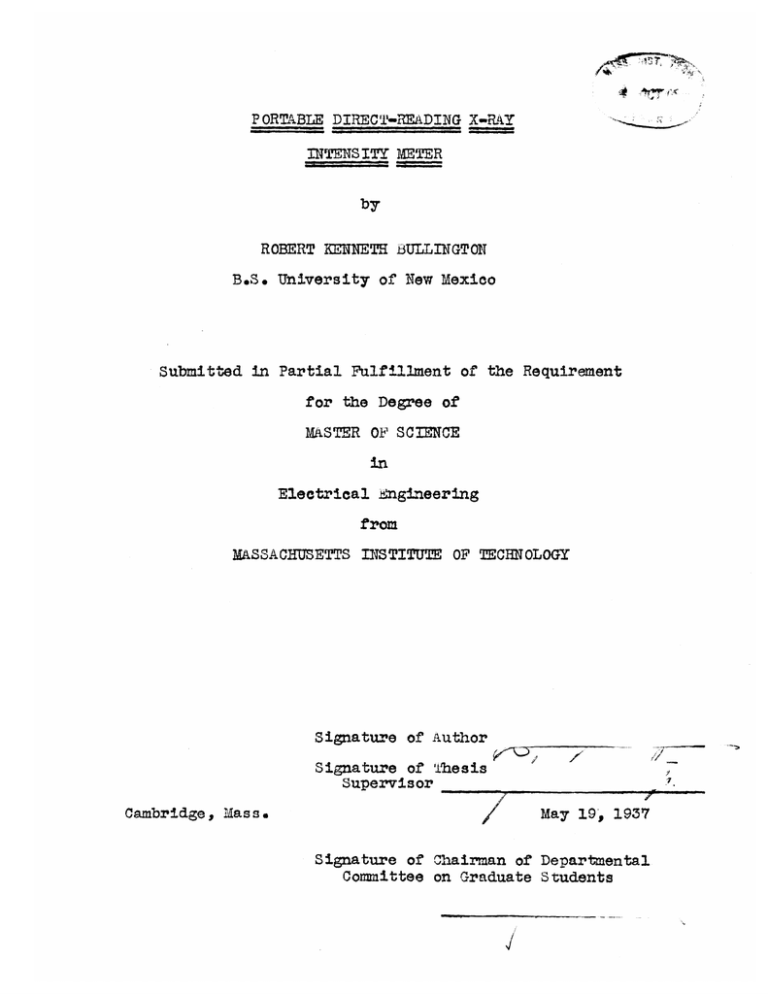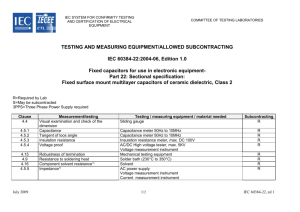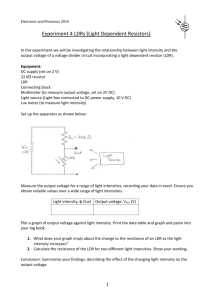r by Submitted in Partial Fulfillment of ... for the Degree of
advertisement

r -) PORTABLE DIRECT-READING X-RAY INTENSITY METER by ROBERT KENNETH BULLINGTON B.S. University of New Mexico Submitted in Partial Fulfillment of the Requirement for the Degree of MASTER OF SCIENCE in Electrical Engineering from MASSACHUSETTS INSTITUTE OF TECHNOLOGY Signature of Author Signature of Thesis Supervisor Cambridge, Mass. /7 -- 7 May 19, 1937 Signature of Chairman of Departmental Committee on Graduate Students 7------ AC KLED GMENT The author wishes to acknowledge and thank Prof. Johnlm G. iLrump for many ideas and suggestions, and Dr. Richard Dresser and Dr. Jack Spencer of the Collis P. Huntington Memorial Hospital for their aid in testing, and for the use of X-ray equipment. TA B LE 0 F 0N TEN T CiAPTE R PAGE NO. I i_ :: "INTRODUC TI ON Past and Present Methods of Measuring X-Ray Intensity . DESCRIPTION OF INSTRMIENT Used in this Investigation. ***************o***oo DrMvi7ngs.o , TEST RESULTS 13 dI, CONCLUSION ...... o.o BIBLIOGR AP-HY ..... o .................... 15 13 CHAPTER I INTRODUCTION Any scientific investigation and use of the therapeutical properties of X-rays must be based en intensity measurements. A recording of voltage and milli- amperage, while sufficient for most applications of X-rays in industry, is not accurate enough for medical purposes. In recent years, the use of X-rays in treat- ing imalignant diseases has increased rapidly, creating a greater need for more satisfactory and more convenient intensity-measuring instruments. Various properties of X-rays have been used to measure their intensity. The effects of X-rays on pho- tographic plates, fluorescent screens, and photoelectric cells are subject to considerable error due to interpretation, and due to the "fatigue" of the fluorescent screens and light-sensitive metals. 'he use of biologi- cal standards, such as erythema doses, and the action on a quantity of fruit flies or other biological material, is also subject to many variations, but found favor due to the simplicity of measurement (from a medical point of vievw). As the intensity of X-rays at any point is a function of many variables, including tube current and voltage, distance of the point from the target, filters, wave form -1- of the applied voltage, tube peculiarities, transmitting medium, and composition and position of surrounding objects, it is obvious that, in order to compare results, an independent standard is necessary. Since the adoption in 1928 of the roentgen unit, the measurement of X-ray One intensity hfQe been on a definite physical basis. roentgen per second is that intensity of X-rays which, when the secondary electrons are fully utilized and the wall effect of the chamber is avoided, will produce in one cubic centimeter of standard air one e.ss.u of sat- Jtus, under the above conditions, an uration current. intensity of one roentgen per minute will produce a saturation current of 5.56 x 10" 1 2 amperes per cubic centimeter. '±e standard chamber for intensity measurements based on the roentgen unit consists of two parallel plates with the X-ray beam passing between them. section of one plate is A small insulated from the remainder which serves only to reduce the edge effects. A potential dif- ference great enough to obtain saturation current is placed between the plates, and the current is measured on a galvanometer. The plates are separated enough so that the secondary electrons will be absorbed before reaching the plates. The volume is taken as the product of the area of the lead slit defining the beam, modified if nec- essary by the divergence, times the width of the insulated -2- section in the direction of propagation of the beam. Thus, from the current and the volume, second (r's the roentgens per per sec.) may be obtained. The standard chamber is necessary as a basis for comparison and for very accurate work, but its use in practical, routine measurements is very limited. It is rela- tively large; it must be fixed in position; the galvanometer needs delicate adjustments, and the intensity can .- not be measured at the time and point of application. Also, as the tube voltages are increased, the separation of the plates must be increased in order that the effects of the walls may be avoided. In order to provide an instrument more suitable for everyday work, many variations of the "thimble"' condenser type were developed. Essentially, the thimble type con- sists of a small cylindrical chamber with volumes from a fraction to several cubic centimeters, in which the wall of the chamber is one electrode, and a small wire along the axis is the other. The condenser chamber is charged to a definite value by means of batteries and is then placed in the X-ray beam at the point Where the measurement is desired. After a measured time interval (usually of the order of one minute), the chamber is removed and the remaining charge is measured. The electrometer that measures the discharge is calibrated in r units, so that the r per minute, or r per second, can be obtained direct- -3- ly from the amount and time of discharge. As the ionization currents are proportional to the third power of the atomic number, it would theoretically be possible to avoid the effects of the walls completely, if the walls were made of some substance that had the same effective atomic number as air. Practically, it is found that several light materials (horn, hard rubber, etc.) can be used satisfactorily over the range of voltages now in use. Such an "air-wall" chamber is coated with a solution of graphite or some other conducting material. This type of instrument has proved very useful due to its portability, ease of reading, and the fact that it can be used at or near the point of application of X-rays before or during treatment. The chief objections to the condenser type are that its readings are not continuous, but are only average values over the time interval, and that its use necessitates the exposure of the medical attendant to the X-rays in the placing and removing of the chamber. Consequently, the customary procedure is to take measurements periodically with the thimble chamber for *The effective atomic number of air is 7.69. Hard rubber (C90 8 )with 9% sulphur would be equal to air in this respect. For detailed discussion and formulae, see reference (3). "4- definite combinations of voltage, current, distance, fil- ters, etc., and between measurements to assume the intensity is the same when the values of this combination of known variables is repeated. With all else equal, the intensity of X-ray output varies as the currentand approximately,as the square of the voltage. At higher intensities, the objections to the condenser type instruments increase. For a given amount of radiation, the treatment time decreases and the importance of variations in intensity is increased; also, the undesirable exposure to attendant is increased. Therefore, the ideal chamber would be one that would give a continuous indication outside of the treatment room of the intensity at any desired point inside, both before ,nd during treatment. It should also be one that could be moved easily, and would operate at ordinary voltages. From the definition of the roentgen unit, it is seen that the radiation absorbed is proportional to the number of ions produced per cubic centimeter per second in the absorbing material, multiplied by the product of the volume and time. In general: r's = No. of ions produced SK ( per c.c. per sec. -5- x Vl. x time in sec 60 and the resulting charge, or currentmust be a measurable quantity. volume, 1he standard chamber uses a relatively large and the current is measured on a sensitive gal- vanometer. The condenser type uses a small volume and a less sensitive meter in order to gain portability' but with an increase in the time interval. It is possible that in order to gain portability and continuous reading the chamber be filled with some gas or liquid giving a much larger number of ions than air for a given intensity. However, as the roentgen unit is defined in terms of air, such a method necessitates a number of correction factors due to leakage and changes in the gas or liquid, and if used on different wave lengths, especially due to its peculiar absorption and emission spectra. These three types are indicative of all methods of measuring the original ionization current. ternative is The other al- to amplify the initial current without ob- jectionable error so that a proportional current may be read on a suitable portable meter, and thus achieve both portability and continuous reading. -6- CHAPTER II DESCRIPTION OF INSTRUMENT The X-ray intensity meter employed in this investigation is an ionization chamber, similar to that used in the condenser type instrument, connected by means of a fifteen or twenty foot shielded cable to a vacuum-tube amplifier. 'ihe chamber, cut from a three-quarter inch ebonite cylinder, has a volume of approximately ten cubic centimeters. The wall is one-sixteenth inch thick and is painted on the inside with aquadag (colloidal graphite) to make it conducting. The other electrode is a small aluminum wire along the axis of the cylinder. The holder is made of the same ebonite cylinder, and the cable is fitted to it with a minimum of air space. Another chamber of approximately three cubic centimeters was made, chambers of any desired volume could be made to fit and the same holder; the insertion of an aluminum wire of proper length would be the only necessary change. It was found that a voltage of approximately one hundred volts was necessary to provide saturation currento This potential is obtained from three very small 45V bat- teries placed inside the case (total space taken, 2 x 4- x 5 inches). The current taken is so small that -7- iI, I ii I~ NC fL II '3 Q 'E: g rL po g 1~ 0 N .jN -"4 the batteries will have "shelf" life. Although it should be possible to obtain the potential for the chamber from the stabilizing tubes across the rectifier output, it was considered impractical. A small change in chamber voltage does not affect the ionization current collected, but it does produce an appreciable charging current and The use of batter- thus decreases the over-all stability. ies was cheaper than standard regulator tubes, and provided absolute constant potential. The determination of the shape and volume of the chamber is a compromise between sensitivity on one side, and on the other, the necessity of having a chamber that can be placed near or on the patient, and in which the intensity is uniform over its cross-sectiono The vacuum-tube amplifier circuit is of the type suggested by R. D. Huntoon (4), using a duplex-diode, high-mu triode. The recording meter is placed in a bridge between the triode and the diode circuit; the other two points of the bridge are the cathode and the positive side of the tube voltage. The effect of plate voltage fluctuations is overcome by the use of "mu balance", age is that is, the grid volt- set at a value equal to the plate voltage divided by the amplification factor. Thus, fluctuations in supply voltage affect grid and plate voltages proportionally. With the 2A6 tube these values are very near the recontnended operating conditions. The two diodes are connected together, and are used to offset the effects of emission changes due )e 3 u Qf C3 to a continued change in voltage. Definite changes (two volts or more) in supply voltage cause a momentary unbalance in the bridge, but equilibrium is restored after the thermal lag necessary for the filament temperature to adjust itself to the new filament voltage. The conditions to be satisfied are (4): R4 i d = R 5 ip dI dlf R4 dId R5 dIl In balancing, the grid bias resistor R2 is varied until fluctuations in supply voltage have little or no effect on the bridge. As the emission is increased there will be for each value of resistance R6s a value of filament voltage at which the deflection on the meter will reach a maximum and reverse for further increase in emission. 'Lhe value of diode resistance used is that which will produce the maximum point at or near the rated filament voltage. With one side of the input and the transformer core grounded, the amplifier gave stable readings with an amplification of the order of twenty thousand. Slight changes in the value of R5 and R6 were necessary when the amplifier was placed in a grounded case. utes to warm up properly. -9- It requires about ten min- Ordinary twoPwire cable with good rubber insulation was found to be satisfactory for the leads from the chamber to the amplifier. not troublesome, The leakage, although measurable, was as it was constant and its effect could be balanced out by adjustment of the bridge. A much more troublesome possible error lay in the fact that X-rays, either scattered or directly from the target, would produce ions in the holder or insulation surrounding the leads. If ions collected from such sources were appre- ciable in comparison to the number collected in the chamber, the resulting deflection would be a function of the position of the cable, and therefore of little value. The hard rubber holder was made with as little air space as possible, and cable with solid insulation was chosen. The seriousness of this error could not be readily predioted, but on test, it was found negligible. All the surplus cable was taken from the room, and then all the surplus was coiled directly in the path of the beam. There was no readable difference between the deflections for the two positions. With a grounded shield, the cable can be moved or coiled in any position without changing the balance point. Obviously', there is a momentary de- flection as the cable is in motion and cutting the magnetic field. The meter used was a Weston Model 301 with a fullscale reading of thirty microamperes. -100- The four-way switch (No. 2) in the meter part of the bridge circuit performs two functions. as different chambers and vary- ing intensities may be used, more than one scale is necessary. Also, as the filament is heating, the meter is subject to a disturbing force first in a negative direction, and then in a positive direction. Both of these forces are much greater than that required to give fullscale deflection when the meter is unprotected. Conse- quently, the first position is open, the next position inserts a large resistance in series with the meter, the third, a smaller resistance, and the fourth leaves the meter unprotected. In such an instrument, it is highly desirable to have a means whereby the zero reading may be checked, and adjusted if field. necessary, without disturbing the chamber or X-ray Due to capacity effects it is desirable to have any switch in the input circuit in the grounded lead. Then, when the circuit is open, the chamber and cable is "floating" on the thirty megohm grid leak which is not desirable. A small portion of the plate supply voltage could be taken for a test circuit, and connected to the grid through a high resistance. For example, with a potential of approximately 0.05 volt and sixty megohms in series, a reading of over two-thirds full scale is obtained. ever, this arrangement is How- subject to fluctuations in the supply voltage, and would not be a test covering any -11- trouble in the input circuit. 'the most satisfactory meth- od is to switch the ground on the input circuit from one terminal of the battery to the other. This method leaves one terminal of the battery open when on test, but keeps the cable at a fixed potential. With the bridge properly balanced with the full voltage on the chamber, a change to test position will produce a small, but constant deflection. As the scale is linear, any adjustment around this fixed point is equal to an adjustment around the zero point with the full voltage on the chamber and zero field. The range of the two less-sensitive scales were chosen from resistors on hand. Obviously, they can be changed to meet any need for higher intensities. Some changes with age in the constants of the tubes are to be expected, but as long as the emission for a given filament voltage is substantially the same, the balance point can still be obtained by varying the resistors in the plate circuit (RS ) , and the calibration will not be changed. Obviously, this type of instrument must be calibrated with a standard chamber, or with some reliable instrument previously calibrated with the standard, preferably the former. in the tests made so far, the Victoreen* thimble chamber has been used. VJictoreen Ia~ttr'ument Qo. Cl-evlioan,. , -OBgm -12- I r RELATONwSIP BiETWEEN SCA LE.S j L. 3j -- - -- i 2A --a 4(6 - /Z 8 - 4- cL--~tc~-- -j---------- 20 READIIVGS ON FIRST JCq&LE IN M1CROAMPERES C------- I3 I oo6 00 3 I /NPUT JSWITCH 3 ANO 4 VARIABLE S 2 METER ON-oFFr WITCh S WITCH M/PUT CABLE 4 RESISTORS GR OUN AMPL iFIER IN BRIDGE //5 V. A.C.SUPPLY CASE CHAPTER III TEST RESULTS The tests were made on the radiation given off by a 200 KT. Coolidge X-ray tube using a transformer-kenotron set for power supply. che results show that the relation between meter readings and intensity is linear, with each small division on the meter (5 x ing to a little I0"m amperes) correspond- leas than one-half r per minute. Stable readings from four or five to one hundred r per minute are possible. It is not recommended (with present meter) for intensities below four or five r per minute, as the percentage possible error is greater when a smaller portion of the scale is used. about twenty r per minute, For the usual treatment at the meter gives approximately two-thirds full-scale deflection. The plot of intensity against the milliamperage of the X-ray tube operating at a given voltage is a straight line# The plot of intensity against the square of the voltage of the X-ray tube, the current being held constant, is nearly a straight line; the variation with voltage is as a power slightly greater than two. The presence of a half-millimeter copper filter would be the chief reason for this departure from the theoretical prediction of intensity variation as the square of the voltage. -13- The per- centage radiation absorbed by a given filter varies as the wave length or inversely as the voltage. From the curves it should be noticed that in the plot of meter readings against the intensity as measured by the Victoreen chamber, there is less variation than in The the plot of meter readings against milliamperage. data for both curves were taken simultaneously. This is merely an indication that a continuous-reading instrument will afford better control of treatment, by revealing variations, momentary and over a period of time, not now detectable on the voltmeter and milliamester. Reversing the polarity on the chamber made no dif- ference in the readings. As mentioned before, the ioniza- tion in the cable and holder was found negligible. A small quantity of radium placed near the chamber produced a small reading, but as the field was not uniform over the cross-section of the chamber, the results were of little value. CAL/.BRAT/,iQ CCURVE /8 /4- /2 10 8 6 1- o 2 9 6 6 /o RCOENTG ENS /Z PER 14 16 l N UTE I8 20 22 2f /INTENSIrTY VAR/T/ON W/rTH CuRREqcNT Ar /InrUr4A 7A A/l / TWAr 507 Cfr7., /O'&x/O'i6LD 3 4 /7/L IAl MPEES 5 INTENSITY VARIATION ATr /7 0 .5 2 W/TH VOL T'AGE r iv -rA A., -IT Z.S" (iw'o voLrs)2 .,o - •CrLA-r 3.s CHAPTER IV CONCLUS I ON By using a more sensitive meter (not used here for reasons of economy) the instrument can be made applicable to the measurement of even lower intensities. For the values of resistances used in the bridge, the value of resistance of the meter for maximum sensitivity and stability should be approximately twenty thousand ohms. The meter used had an internal resistance of two thousand ohms. Another meter of greater sensitivity or greater resistance.,or both, would produce better results. An instrument of this type provides, without danger to the medical attendant, a continuous indication of the intensity of X-rays at any desired point, and will enable the recording of intensity as a routine record of each treatment, instead of relying chiefly on the settings of the voltmeter and milliammeter. As varying distances and filters are desirable in medical work, the advantage of a single, continuous-reading indication of intensity, instead of a large number of independent variationsis evident, in both the recording and in the interpretation. "Principles of Electricity" Page and Adams, Van ilNostrand Co. 1931. -150- p 180 - D. BIBLI OGRAPHY I. "Biological Effects of Duggar, Benjamin Vol. 1. McGraw Hill. Radiation". 2. Compton, Arthur H. and Allison, Samuel K. in T1heory and Experiment." Co. 3. Glasser, Otto 1936 'X-rays, D. Van Nostrand 1935. "Small Secondary Instruments". American Journal of Roentgenology 13:457. 1925. 4. Huntoon, R. D. "An Inexpensive Direct-Current Am- plifier"e Review of Scientific Instru- ments 6, 322. 5. October, 1935. Terrill, H* M. and Ulrey, C. To D. Van Nostrand Co. "X-Ray Technology". 1930.




